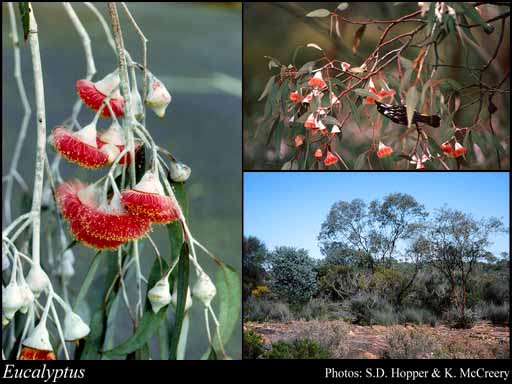- Reference
- Sert.Angl. (1789)
- Name Status
- Current

Scientific Description
Common name. Eucalypts. Family Myrtaceae.
Habit and leaf form. Trees, or shrubs; evergreen; non-laticiferous and without coloured juice; bearing essential oils. ‘Normal’ plants. Leaves well developed. Plants non-succulent; autotrophic. Young stems not breaking easily at the nodes. To 2–36.74–100 m high. Self supporting. Stem growth not conspicuously sympodial. Leptocaul. Helophytic, or mesophytic, or xerophytic. Heterophyllous. Leaves small, or medium-sized, or large; alternate, or opposite; with blades; ‘herbaceous’, or leathery; petiolate, or sessile; connate, or not connate; gland-dotted, or not gland-dotted; aromatic; edgewise to the stem, or with ‘normal’ orientation; simple; not peltate; epulvinate. Leaf blades neither inverted nor twisted through 90 degrees; dorsiventral, or isobilateral; entire; not conspicuously asymmetric; flat; linear, or lanceolate, or ovate, or oblong; ovate, or oblong, or elliptic, or orbicular; one-veined, or pinnately veined, or parallel-veined; cross-venulate. Leaves eligulate; without stipules; without a persistent basal meristem. Vernation not circinnate. Leaf anatomy. Leaf blade epidermis without differentiation into ‘long’ and ‘short’ cells. Guard-cells not ‘grass type’. Urticating hairs absent. Stem anatomy. Secondary thickening developing from a conventional cambial ring. Xylem vessels solitary. Paratracheal parenchyma scanty. Roots. Roots without velamen.
Reproductive type, pollination. Fertile flowers hermaphrodite. Unisexual flowers absent. Plants hermaphrodite. Entomophilous, or ornithophilous. Pollination mechanism unspecialized.
Inflorescence and flower features. Flowers aggregated in ‘inflorescences’; in umbels. Inflorescences simple, or compound. Flowers not in ‘spikelets’. The terminal inflorescence unit cymose. Inflorescences not scapiflorous; terminal, or axillary; without involucral bracts; not pseudanthial; espatheate. The fruiting inflorescence not conelike. Flowers pedicellate, or sessile; bracteolate, or ebracteolate; small, or medium-sized, or large; operculate (calyptrate); regular; not resupinate; neither papilionaceous or pseudo-papilionaceous; 4 merous; cyclic. Floral receptacle with neither androphore nor gynophore. Free hypanthium present; campanulate, or obconic, or turbinate, or urceolate, or tubular. Perianth with distinct calyx and corolla; 8, or 10; 2 -whorled; isomerous; without spots. Calyx present; 4, or 5; not represented by bristles; 1 -whorled; polysepalous, or gamosepalous; entire; calyptrate, or not calyptrate; shed before the corolla, or not shed before the corolla; imbricate, or valvate; regular; neither appendaged nor spurred; persistent, or not persistent. Epicalyx absent. Corolla present; 4, or 5; 1 -whorled; alternating with the calyx; not appendiculate; polypetalous, or gamopetalous; entire. Corolla tube not noticeably adaxially split. Corolla calyptrate; integrally fused-calyptrate, or not integrally fused-calyptrate; imbricate; regular; not spurred; not fleshy. Fertile stamens present. Androecial members indefinite in number. Androecium 20–85–150. Androecial members branched. Androecial sequence determinable, or not determinable. Androecial members maturing centripetally; free of the perianth; free of the gynoecium; all equal, or markedly unequal; free of one another, or coherent; when coherent, 4 - adelphous. The androecial groups opposite the sepals, or opposite the petals. Androecium exclusively of fertile stamens, or including staminodes. Staminodes non-petaloid. Stamens 20–85–150; not didynamous, not tetradynamous; polystemonous; erect in bud, or inflexed in bud; filantherous. Filaments not appendiculate. Anthers separate from one another; dorsifixed, or basifixed; not becoming inverted during development; versatile, or non-versatile; dehiscing via pores, or dehiscing via longitudinal slits; introrse; tetrasporangiate; appendaged, or unappendaged. The anther appendages dorsal. Pollen shed as single grains. Pollen grains not dispersed as long filaments. Fertile gynoecium present. Gynoecium 2 carpelled, or 3 carpelled, or 4 carpelled, or 5 carpelled, or 6–7 carpelled. The pistil 2 celled, or 3 celled, or 4 celled, or 5 celled, or 6–7 celled. Gynoecium non-petaloid. Carpels reduced in number relative to the perianth, or isomerous with the perianth. Gynoecium syncarpous; eu-syncarpous; inferior. Ovary plurilocular; 2 locular, or 3 locular, or 4 locular, or 5 locular, or 6–7 locular. Locules without ‘false septa’; not horizontally divided. Epigynous disk present. Gynoecium stylate. Styles 1; without an indusium; apical. Styles straight in bud, or bent in bud. Stigmas 1; dorsal to the carpels. Placentation axile. Ovules 20–50 per locule; ascending; non-arillate; hemianatropous, or anatropous.
Fruit and seed features. Fruit aerial; sessile; non-fleshy; not an aggregate; dehiscent; a capsule. Gynoecia of adjoining flowers not forming a multiple fruit. Raphe of hemitropous type absent, or present. Raphe of anatropous type absent, or present. Seeds non-endospermic. Perisperm absent. Seeds not conspicuously hairy; with a testa; winged, or wingless. Seed wings not encircling body. Embryo well differentiated. Cotyledons 2; folded; reniform, or bilobed, or bisected. Testa not cracking; smooth; without phytomelan; with a crystalliferous layer, or without a crystalliferous layer. Micropyle not zigzag.
Special features. The funicles not as in Acanthaceae. Non-mangrove species. Juvenile leaves all petiolate, or sessile or subsessile at some stage. Leaves never tightly cordate, subpeltate or peltate. Adult leaves with many lateral veins; with an intramarginal vein distinct from the thickened margin, or with no distinct intramarginal vein. Oil glands without radiating hairs, or with radiating thin-walled blunt-ended hairs. Protuberant oil glands with 4 cap cells, or with 2 cap cells. Oil-gland cap cells smooth. Thin-walled blunted-ended hairs present, or absent. Hairs uniseriately multicellular. Bristle-glands absent. Pith of leafy twigs without large oil ducts. Inflorescence phyllotaxy fixed opposite. Corolla completely congenitally fused with the calyx, or not congenitally fused with the calyx. Stigmatic papillae long, or short. Ovules in vertical rows. Ovules in 2 rows, or 3 rows, or 4 rows, or 5 rows, or 6 rows, or 7–10 rows. Inner integument not resorbed in seed, or resorbed in seed. Outer integument 4 cells thick, or 2 cells thick. Not hosting Glycaspis subgenus Glycaspis, or hosting psyllids from the genus Glycaspis subgenus Glycaspis. Gynoecium and fruit not as in Resedaceae.
Geography, cytology, number of species. Native of Australia. Endemic to Australia, or not endemic to Australia. Australian states and territories: Western Australia, or South Australia, or Northern Territory, or Queensland, or New South Wales, or Victoria, or Australian Capital Territory, or Tasmania. Northern Botanical Province, or Eremaean Botanical Province, or South-West Botanical Province.
Etymology. From the Greek for "well" and "covered"; refers to the operculum or cap which covers the stamens in bud.